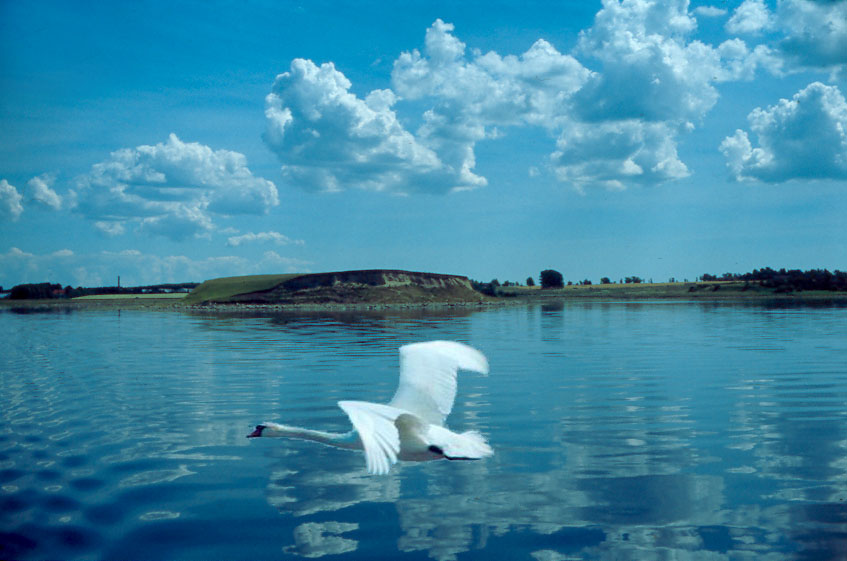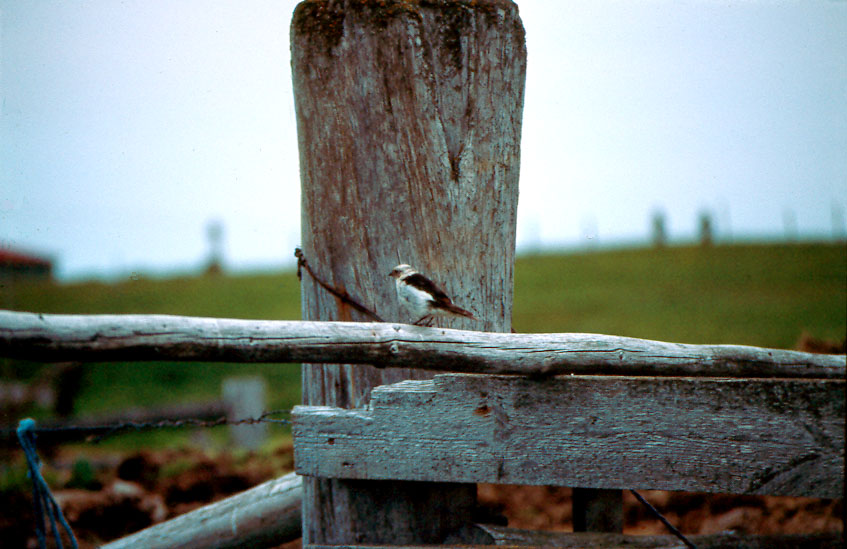Bolund
 Bolund from the west.
Bolund from the west.
Along the eastern side of Roskilde Fjord there is a line of cliffs interspersed with hollows. Starting from the north, they are Jyllinge Klint, Agernakke, Bolund, Risø, Høje Klint and Veddelev Klint. The most striking of these is Bolund – a sharply defined moraine hill which is connected to the salt meadows north of Risø by a narrow isthmus. From the top of Bolund there is a good view over most of Roskilde Bredning (the wide southern part of the fjord). To the south Elleore peeps out from behind the cliffs at Risø. Further west you can see the Bognæs woods, with the cormorant colony at Askehoved. Directly to the west are Gershøj, with Ægholm in the foreground, and to the north west are Østskoven, Skovrenden and Eskilsø. To the north is Jyllinge marina, with Blak in the foreground.
Bolund is a good place for bird watching all year round. Choose a day that is not too windy and bring some powerful binoculars, or even a telescope. It is possible to observe most species without disturbing them. You should however avoid taking dogs, unless on a lead, and keep your distance from the sand martin colony during the breeding season.
Some years, but by no means every year, there is a colony of sand martins on Bolund. These small, neat, brownish birds hollow out nesting holes in the cliff just below the layer of topsoil and can easily be seen from a suitable distance down on the beach.
Early in the summer common tern and arctic tern can be seen nose-diving into the water to catch their prey. It is difficult to distinguish between them in flight. Both species breed on Aegholm, which is visible to the west.
The fjord’s four species of gull may also be seen here. There is a colony of black-headed gull just to the south on Svaleøen by Risø, the common gull breeds on Blak, which is visible to the north, while the herring gull and great black-backed gull both breed on Elleore, which can just be seen behind Risø. All four species forage around Bolund. The black-headed gull and the common gull forage mainly on land, whilst the herring gull and great black-backed gull are most often to be seen on the water. When the fishermen empty their nets the gulls flock around the boats. The only other species of gull found on the fjord – the lesser black-backed gull – is not usually seen on Bolund. In the winter most of the common gulls migrate to the area around the English Channel.
From August to October thousands of greylag geese roost in the little inlet called Bløden, by Risø. From here they travel in big v-formations to feed on the stubble fields. This may happen at any time of day, but is most common in the morning and in the evening. You can also often see the geese grazing in local fields. In winter they migrate to southern Spain, returning to their breeding grounds in Zealand and Skåne at the end of March.
The mute swan, one of the fjord’s most striking and familiar birds, can be seen from Bolund all year round. Early in June, when the young are a few days old, each breeding pair occupies a territory on the coast and stay there until the young are able to fly in September. It is often possible to see several families from Bolund. In July and August the non-breeding swans gather in large flocks to shed their flight feathers. On Sælklemmerne north of Bolund and along the south coast of Eskilsø there are often 500-1000 moulting swans.
To the south west, a little to the west of Elleore, lies Askehoved, on Bognæs, where there is a mixed heron and cormorant colony. Cormorants forage all over the fjord from early spring to late autumn. They are often to be seen sitting on fishing stakes. They spend the winter in central and southern Europe.
In autumn and in mild winters, thousands of coots gather in flocks and roost in the fjord. When the wind is from the east flocks of coot are frequently seen around Bolund, where they eat both plants and bottom feeders, for which they dive in the relatively shallow water.
In spring and autumn a lot of waders pass through the fjord. When there is low water, because of a south-easterly wind, they often roost on the mud flats, but at high water they either stand on the islets or pass through the fjord without stopping. The most common species are lapwing, golden plover, oystercatcher and sandpiper. Avocets often move, with their young, from the islets to the salt meadows along the coast so you might well be fortunate enough to see them at Bolund.
In winter a large number of Russian and Scandinavian birds come to the fjord. There is a good chance of seeing these from Bolund. For example, in late winter you might see the goldeneye’s amusing mating game, in which the males court the females with nodding movements. The call of the whooper swan can often be heard where there are gaps in the ice, and when the fjord is frozen over you might see a white-tailed eagle standing on the ice beside a swan corpse, surrounded by crows. There are often flocks of the beautiful snow bunting on the salt meadows in winter.
There is a car park (complete with information board) on the road adjacent to Bolund, and from there you can walk over the meadow and cross the isthmus out to Bolund.

The snow bunting, a winter visitor, on the salt meadow.
